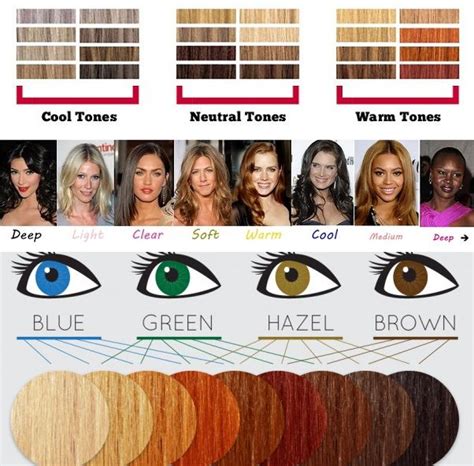Choosing the perfect hair color can be daunting, especially when you have to consider your skin tone. But fear not! Here’s a comprehensive guide to help you find the hair color that will complement your skin and enhance your natural beauty.

Understanding Skin Undertones
Before choosing a hair color, it’s crucial to determine your skin’s undertone. This is the subtle color beneath the surface of your skin, and it comes in three main categories:
- Cool: Pink, red, or bluish undertones
- Warm: Yellow, golden, or peachy undertones
- Neutral: A balance of both cool and warm undertones
Ideal Hair Colors for Different Skin Tones
Based on your skin undertone, here are some hair colors that will flatter you:
Cool Skin Tones
- Black: Creates a striking contrast and accentuates the cool tones in your skin.
- Dark Brown: Rich and elegant, dark brown complements cool skin while adding warmth and depth.
- Blonde: Platinum or ash blonde can create a sophisticated and icy look, enhancing your skin’s pink undertones.
- Red: Deep, cool-toned reds like burgundy or auburn can bring out the red undertones in your skin.
Warm Skin Tones
- Golden Blonde: Warm shades of blonde, such as honey or amber, will enhance the yellow undertones in your skin, creating a radiant glow.
- Brown: Warm brown hues, like caramel or chocolate, will complement your skin’s golden undertones and create a rich and natural look.
- Copper: Copper or bronze tones can add warmth to your skin and accentuate its peachy undertones.
- Red: Vibrant shades of red, like fire engine red or copper, will bring out the warmth in your skin.
Neutral Skin Tones
- Any Color: Neutral skin tones have the flexibility to wear any hair color. However, warm colors like golden blonde or honey brown will accentuate the warm undertones, while cool colors like ash blonde or black will enhance the cool undertones.
Experiment, Experiment, Experiment!
Remember, these are just guidelines. The best way to find the perfect hair color for you is to experiment. Try on different shades using a wig or temporary hair dye to see which ones flatter your skin the most.
Tips and Tricks
- Ask for a professional color consultation at a reputable salon.
- Bring a photo of your natural hair color and your desired shade to the consultation.
- Consider your hair texture and density when choosing a color.
- Opt for semi-permanent or temporary hair dye for experimenting with different shades.
- Maintain healthy hair by using color-protecting shampoos and conditioners.
FAQs
1. How do I determine my skin undertone?
* Examine your veins on the underside of your wrist in natural light. If they appear blue or purple, you have cool undertones. If they look green, you have warm undertones.
* Another method is to hold a white piece of paper next to your face. If your skin looks yellow or golden next to it, you have warm undertones. If it looks pinkish or reddish, you have cool undertones.
2. Can I change my skin undertone?
* No, your skin undertone is determined by your genetics and cannot be permanently changed. However, you can use makeup and hair color to enhance or neutralize certain undertones.
3. What if I have a combination of skin undertones?
* This is common. If you have a mix of warm and cool undertones, opt for hair colors that have both warm and cool elements, such as strawberry blonde or golden brown.
4. How often should I touch up my hair color?
* The frequency of touch-ups depends on the type of hair dye used and the rate at which your hair grows. Generally, permanent hair dye lasts for 6-8 weeks, while semi-permanent dye lasts for 4-6 weeks.
5. Is it possible to fix a bad hair color?
* Yes, but it may require multiple treatments. A color correction specialist can use corrective color to neutralize or remove unwanted tones.
6. What should I do if my hair color turned out too dark or too light?
* If your hair is too dark, you can use a color remover to lighten it. If your hair is too light, you can use a toner to add warmth or depth.
